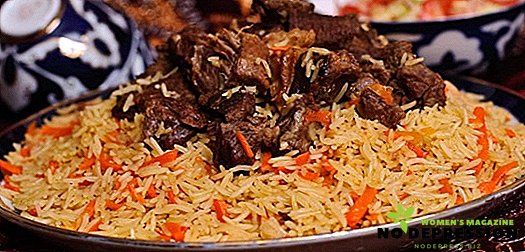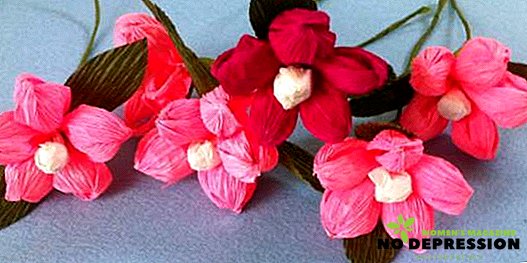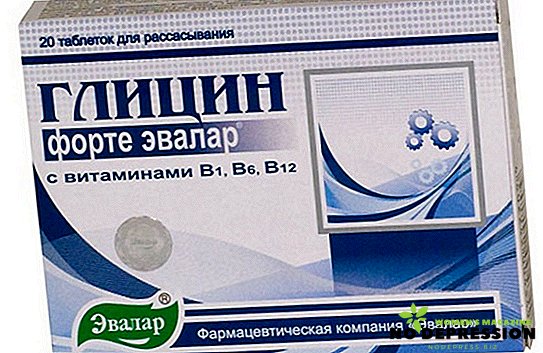A beautiful flowering, very bright plant - hydrangea - knowingly received such a beautiful name. Since the main area of its distribution are Asian countries - Japan and China, here is used a completely different name of the flower - adzai, or purple sun flower.
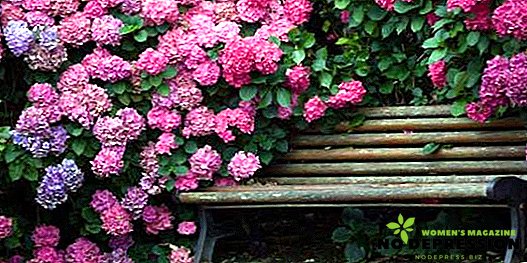
True, experts use a completely different name - hydrangea, for its excessive love of moisture. However, outside of this narrow circle, such a name is practically not used.
However, in Russia, this flower is known as the hydrangea, in honor of the beautiful princess of the Holy Roman Empire.
Types and varieties of hydrangeas
At the moment there are a large number of different species of this plant. At the moment in Russia only the garden hydrangea is grown in houses, all other types are intended specifically for outdoor planting.
- Panicle hydrangea - differs very small size. Standardly, it does not grow more than one and a half meters, and the inflorescences are quite lush, reaching about 30 cm. Its planting and care does not require a lot of work, therefore it is an ideal option for a novice gardener. However, the beauty of an almost complete bush shrouded in flowers will give the garden a unique atmosphere. At the moment, there are several dozens of very different varieties of panicle hydrangea of various shades. The most popular at the moment are cream and purple;

- Chereshkovaya hydrangea is almost not found in the gardens of Russia. But even around the world is considered the most rare species. It is a blossoming vine, which can reach a height of 25 meters. All this led to the fact that they use it like ivy, allowing it to wrap around the walls of houses or arches. Perhaps it is the easiest type of hydrangea to care for, because due to the fact that there is no formation of the trunk, it is only necessary to ensure a sufficient amount of moisture. Since the plant grows quite massive, before planting should be cleared from the weeds a large space.
It affects how much this plant is prepared for the climate of Russia, because it can grow in most parts of the country. As with all vine plants, additional air roots are formed, through which nutrients can also be absorbed. The leaves have a heart-shaped appearance, reaching about 10 cm. At the same time, the inflorescences are of a corytic type and grow rather large. Standard color - white and pink. Beautiful lush buds have a fairly strong aroma;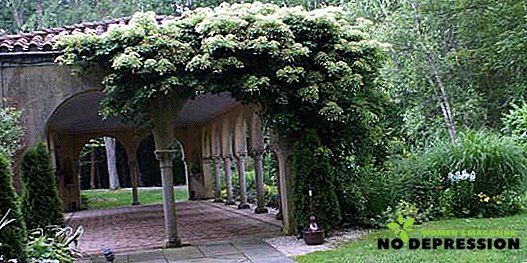
- Tree hydrangea is a rather large shrub up to 3 meters high. Unpretentious nature makes it very popular among numerous gardeners. Flowers are standard white, gathering in large inflorescences, delight the eye for quite a long time, in warm regions until late autumn. The leaves are rather large, oval-shaped. The main disadvantage of this plant is its thermophilicity, so it can often freeze in winter. However, its magical property is the ability to quickly recover in the spring, delighting with new flowers. Perhaps it can be compared with the phoenix bird for its resurrection ability;
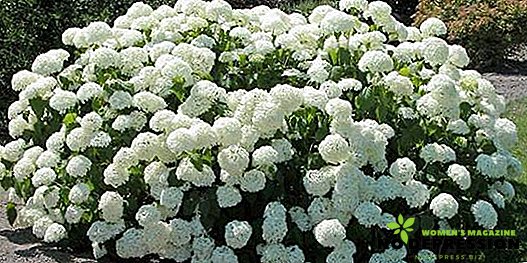
- Large-leaved hydrangea in Russia is grown at home. It takes a very strong winter shelter to grow it in open soil. Perhaps of all kinds, it is she who has the greatest whimsicalness in cultivation. According to the name, the flower has rather large oval-shaped leaves, usually slightly pointed. Inflorescence is amazing, the most common are pink, blue and green. At home, usually reaches only 60 cm, but the street grows to 2 meters. Inflorescences grow on the top of the shrub, forming a flower cap;
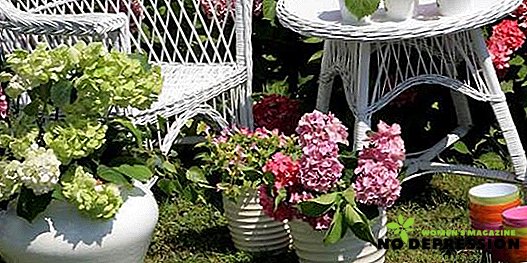
- The hydrangea variety Pinkie Winky refers to the grade paniculata. Bred by the Belgians only eleven years ago, it showed itself as a highly ornamental variety. A very unusual look will delight any eye. The color that changes during flowering is especially striking - it smoothly flows from white to pink, and later to red. The flowering period lasts until mid-autumn, and the crown does not fall apart at all due to sufficiently strong branches;
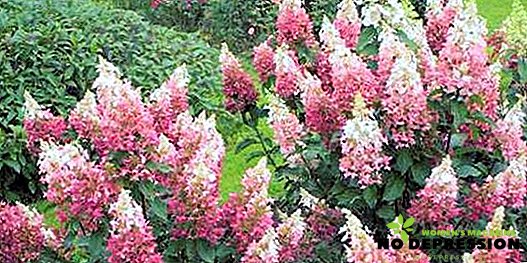
- Variety Vanilla Frazie one of the new products in the world of hydrangeas. It is a very light-loving plant with beautiful flowers. Its dimensions are striking - the rounded crown reaches a diameter of 2 meters and a height of one and a half. Decorative qualities are expressed in upright shoots of red. Since the branches do not have a large fortress, the crown bends under the weight of flowers, forming a blooming ball. The leaves have an oblong shape, and to the touch resemble velvet. It has a fairly good frost resistance, but gardeners still advised to protect the plant from temperature extremes.
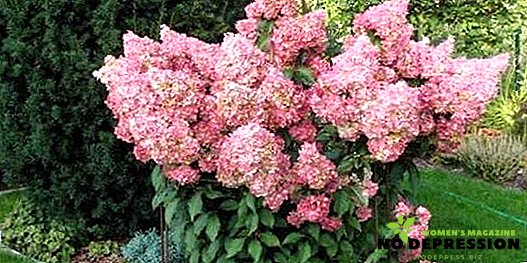
Land preparation for planting
Before starting the direct landing of hydrangea in the ground requires careful preparation of the soil. The most optimal is a well-drained and fairly light land. This will provide constant moisture to the plant, which requires constant watering. Add to the ground humus, peat and other fertilizers, it is desirable that the soil becomes acidic.
Land preparation should begin in advance so that the ground could settle before landing. Also an important condition in choosing a place becomes light, however, the flower can grow in partial shade. Select the site so that the house is shielded from the bush.
After the place is chosen and sufficiently prepared, suitable holes should be dug. The depth and diameter of forty centimeters is enough. At the bottom of each of them should be added to 50 grams of any mineral fertilizers.
Since the hydrangea plant is quite unpretentious, it does not require other preparatory procedures.
Perennial hydrangea: outdoor planting
At the moment there are two stages of planting this plant in open ground:
- With the help of seeds;
- Through seedlings.
Consider the first stage. Usually the seeds come to Russia from Asian countries, where this flower is most often found in the wild. To grow a flower, thus, is quite simple, but the amount of time for which this process will drag on will seem like an eternity.
 As a rule, hydrangea is transplanted with seeds in the autumn period. In the pre-prepared soil it is necessary to sow the seeds. It is necessary to fill them with the same nutrient mixture. Since the plant will need a huge amount of moisture, you should thoroughly spray the soil with a spray bottle.
As a rule, hydrangea is transplanted with seeds in the autumn period. In the pre-prepared soil it is necessary to sow the seeds. It is necessary to fill them with the same nutrient mixture. Since the plant will need a huge amount of moisture, you should thoroughly spray the soil with a spray bottle.
For faster germination, cover the container with film or glass. This will maintain a more uniform air temperature. However, in order for seedlings to breathe, periodically remove this barrier.
The first shoots should appear in about a month. After this, a dive procedure should be carried out twice: with the development of leaflets and in May.
After that, you should start planting seedlings. Have to plant in small pots, for each sprout should be used separately. After that, start to make pots in the garden for the daytime, so that the plants are accustomed to the weather. Usually, growing hydrangeas before planting takes a couple of years. Finally, the flower itself turned into a sapling. Now go to the second stage.
This procedure is carried out in very early spring, usually before budding.
In the selected place in the 40-centimeter hole pit one seedling of shrubs, which should be carefully prikopat. After that, mulching is carried out by means of sawdust or pine needles. This will help retain such important moisture in the soil.
Care for hydrangea planted in open ground
Due to the extreme simplicity of this plant, it does not require constant care. Flower durability is truly amazing, because it endures frost, gas pollution and other adversities. However, if you want to have an amazing flower bed, then you will have to make an effort anyway. What procedures are necessary:
- Permanent watering - water should be constant. It is desirable that the earth did not even begin to dry. If hydrangea is not enough water, then it will quickly lose leaves, gradually fading. It is desirable to defend water for irrigation.
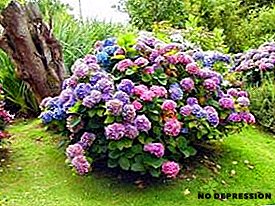 Twice a week it will be necessary to use about 50 liters of liquid for each bush. Constantly carry out mulching, it will help retain moisture, which will allow watering less often;
Twice a week it will be necessary to use about 50 liters of liquid for each bush. Constantly carry out mulching, it will help retain moisture, which will allow watering less often; - Top dressing occurs about 4 times a year throughout the spring - summer season. The first top dressing is carried out with organic feed. It will allow inflorescences to develop well. The second is responsible for the direct growth of buds. The most optimal is fertilizer with potassium, phosphate and urea. The third fertilizer used is mineral. Special hydrangea feed is applied immediately before the plant begins to prepare for winter sleep;
- Pruning to form the crown is made before flowering. After this period, all budding buds should also be cut, otherwise it prevents the next flowering;
- Warm winter shelter, especially for thermophilic varieties of hydrangeas.
Pruning and reproduction of hydrangeas
Pruning a plant is an obligatory step if you want a lush flowering. Usually the first pruning is carried out only on a three-year plant. In early spring shoots of the current year should be cut. If this is not done, the copious flow of juice will cause the hydrangea to die. It is necessary to carefully select the time for such pruning, waiting for a small swelling of the kidneys. Standardly, every kind of flower wakes up in its own period, therefore it is impossible to name the exact period.
In the autumn it is also necessary to carry out the trimming procedure. The plant should be completely rid of damaged branches. Leave only a few shoots, this is quite enough for flowering next year.
The reproduction of this shrub occurs using cuttings, that is, part of the stem that has buds on it, it does not matter whether it is one or several. However, if a growing shrub is large enough, you can propagate it by dividing the bush.
Before you start grafting, you should carefully prepare the ground. Humidity should be very high. The next step is to carefully remove the stem from the ground. Wash the root thoroughly so that no traces of soil are left. Take a very sharp knife, with the help of which it will be enough just to divide the root system. The root is planted back, and the ends of the shoots should be trimmed.
From the resulting stem, several shoots are cut off first. They need to be immediately put into the water, otherwise they quickly dry up. After that the cutting is cut. The tip of the shoot is immediately cut off, because for cuttings it is not suitable in any way.
The green part of the shoot should be divided with a knife. See that each of them contains at least four leaflets.
In order to quickly appeared roots, you should use a special simulator. After the roots have been formed, the cuttings become suitable for planting in the soil.
Diseases and pests settling on hydrangeas
Despite the huge number of advantages that gardeners receive, deciding to grow hydrangeas in their garden, even these plants have a number of problems. The following describes the diseases and pests that attracts shrubs.
- Tracheomycous wilt. If, when planting in the soil, there were particular pathogen fungi, then this disease will become a real nightmare. The defeat begins with the roots, which quickly rot. Since the disease is caused by fungi, the further development of the mycelium penetrates the vascular system of the plant, preventing the flow of nutrients. After that, the leaves of the plant gradually dry out, and on slices of cuttings you can see the patches of mycelium. That is why you should carefully inspect the stalk before planting, because the hydrangea by this time may already be infected;
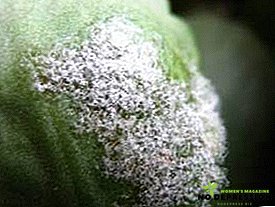 White sclerocial rot also occurs because of the fungus that remains in the ground in the form of sclerotia. Hitting the roots, the fungus quickly causes the plant to dry out and brown. After that, the leaves are covered with white bloom, resembling cotton wool. After some time, black sclerotia form from this deposit;
White sclerocial rot also occurs because of the fungus that remains in the ground in the form of sclerotia. Hitting the roots, the fungus quickly causes the plant to dry out and brown. After that, the leaves are covered with white bloom, resembling cotton wool. After some time, black sclerotia form from this deposit;- Gray rot is currently considered the most common disease in this culture. Its pathogen is a soil pathogen, which does not cost only one plant, but infects the entire area. The disease manifests itself as a manifestation of brown spots on the stems, they gradually pass to the leaves. Dead spots crack and fall out, leaving holes. If rainy weather lasts a long time, a grayish mycelium appears, due to which the disease got its name;
- European cancer spreads with imported planting material. The first step is the defeat of the bark, which cracks and exposes brown ulcers. They gradually grow, because of what occurs the dying off of a bush;
- Mealy dew looks like small specks of greyish bloom. Gradually, they increase and darken, and the affected areas become brown.
In fact, this is not a complete list of diseases that affect hydrangeas, but they are the most common, so the first thing to look for is these signs.
In addition, hydrangeas are usually a breeding ground for small pests. It should be borne in mind that such insects are distributed almost throughout the garden, so you should check all the plants. The most common are:
- snails;
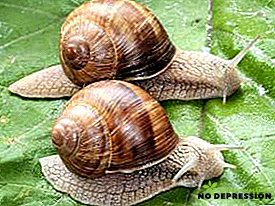
- different types of aphids;
- spider mite;
- various bugs: berry, woody and meadow;
- nettle weevil;
- butterfly caterpillars;
- gall nematode and many others.
Be sure to use special tools that will help fight pests and diseases. If you can see that the plant is damaged, it is better to immediately get rid of this flower.
Most importantly, remember that spraying does not need to be done during the flowering period, it will damage the buds without benefiting the leaves.
Features of planting and caring for hydrangeas in the Moscow region and Siberia
In fact, it is quite easy to grow hydrangeas in the Moscow region. This is especially true for tree varieties, for paniculate need more careful care. This mainly relates to the onset of winter sleep, heat-loving varieties should be carefully wrapped so that the plant survived the winter.
 A swamp was spread throughout almost the entire Moscow region, therefore the soil here is fertile enough to grow hydrangea. A nearby forest provides windless terrain.
A swamp was spread throughout almost the entire Moscow region, therefore the soil here is fertile enough to grow hydrangea. A nearby forest provides windless terrain.
The climate of the Moscow region does not require any special special measures for planting and care, except for the winter wrap.
In contrast to this region, the harsh climate of Siberia contributes little to the cultivation of plants, in general. However, this is quite possible to implement, it is enough just to use the options.
The first thing is to choose the right type of flower. The most common here are paniculate varieties of hydrangea. Dwarf varieties should be chosen so that the height of the adult plant does not exceed a meter. Usually these species, for example, Vanilla Fresh or Bobo, are specially bred for keeping low temperatures.
Other varieties can also be grown, but they will not please you with abundant flowering. Standardly they are dug before the start of frosts, then later in the spring to land in open ground.
The main point of care is insulation for the winter. Be sure to carefully cover the roots, for this is used rotted manure, and then - fallen snow. This will help protect the plant from frost, as well as additionally nourish the roots with water in the spring. The remaining recommendations remain the same.
If you carefully follow all the recommendations and diligently carry them out, the hydrangea will delight you with its magnificent flowering in the summer and autumn.
Additional information on growing hydrangeas - in the next video.








 Twice a week it will be necessary to use about 50 liters of liquid for each bush. Constantly carry out mulching, it will help retain moisture, which will allow watering less often;
Twice a week it will be necessary to use about 50 liters of liquid for each bush. Constantly carry out mulching, it will help retain moisture, which will allow watering less often; White sclerocial rot also occurs because of the fungus that remains in the ground in the form of sclerotia. Hitting the roots, the fungus quickly causes the plant to dry out and brown. After that, the leaves are covered with white bloom, resembling cotton wool. After some time, black sclerotia form from this deposit;
White sclerocial rot also occurs because of the fungus that remains in the ground in the form of sclerotia. Hitting the roots, the fungus quickly causes the plant to dry out and brown. After that, the leaves are covered with white bloom, resembling cotton wool. After some time, black sclerotia form from this deposit;
